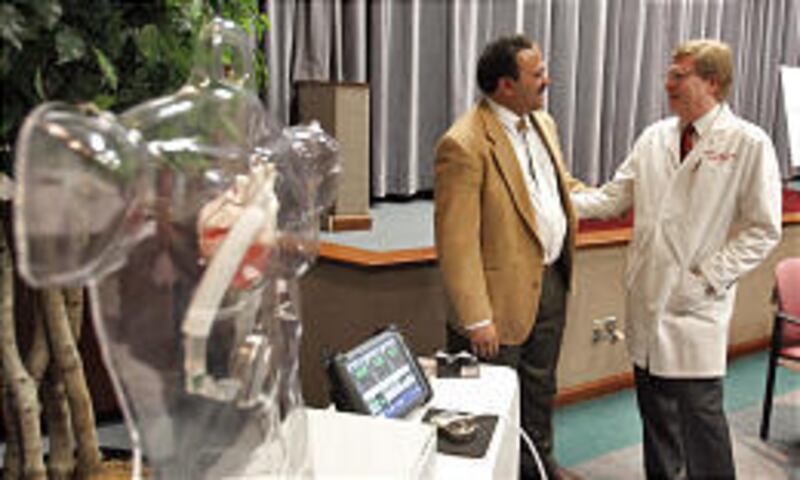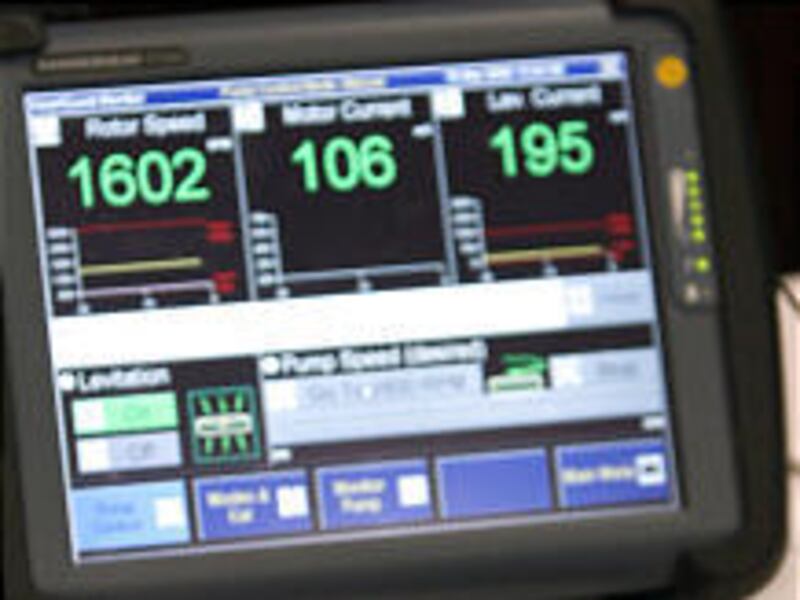A "next-generation" artificial heart device created in Utah has been implanted in a 67-year-old man in Greece. The implant is unique among heart pump-assist devices because it has no touching internal parts and is expected to last much longer because of that design.
It will likely be early next year before the device can be used in a clinical study in the United States because of the complex Food and Drug Administration approval process. It's easier to establish a clinical trial in Europe, and many American technologies get their first human testing there for that reason.
Dr. James Long, director of the artificial heart program at LDS Hospital, was part of the surgical team that placed the pump in the abdomen of the man last Wednesday. The patient had a long history of congestive heart failure that likely would have killed him. He's now doing well, Long told a news conference Thursday at LDS Hospital.
The Greek patient needs the assistance while his heart gets strong enough to work without it, Long said. In effect, it's buying the Greek valuable time. It is not designed to be temporary for all patients.
The manufacturer, WorldHeart, bought a Utah company that has been developing the ventricular-assist device (VAD) for several years. It builds on the now long-established reputation of left ventricular assist devices (LVADs), which Long and others have been implanting for years. But it also is expected to improve on them in significant ways.
During the news conference, LVAD user Jack Larsen sat at the front of the room, the click-click of his heart pump audible. One of his grandchildren calls him "Tickety Tock Grandpa," he joked. The WorldHeart rotary VAD is silent.
It's demonstrably smaller and expected to be much sturdier. The propeller is suspended in an electromagnetic field where nothing grinds on it as it pumps blood and boosts the heart's efficiency. That spinning piece is also the only moving part, making the WorldHeart VAD the only "bearingless, fully magnetically levitated implantable pump under study in clinical trials," according to a release by LDS Hospital. Clotting is also expected to be less of a problem.
The fact that it's significantly smaller makes use feasible in smaller adults and adolescents. A tiny prototype is being developed as well for use in infants and children, said Pratap Khanwilkar, who oversees work on the rotary VAD in Utah.
An estimated 4.7 million Americans have congestive heart failure, which kills about 300,000 people each year. Right now, patients have three options, Long said, when the heart failure becomes severe: They can get a heart transplant (only 2,000 heart transplants were done in the United States last year; the organs are simply not available), rely on a VAD of some sort to boost the heart's ability to function, or make peace with the fact that they're dying.
Many people who would not qualify for a heart transplant because of age or medical conditions qualify for an LVAD, including Larsen and Herb Koehler, who both talked of the difference in their lives since they received LVAD implants.
Much of the seed money for development of the Utah-born VAD came from the Heart and Lung Research Foundation at LDS Hospital, while later grants from the National Institutes of Health have helped keep the project alive.
Utah's long history with the artificial heart began in 1982 when the Jarvik-7 total artificial heart was implanted in Barney Clark at University Hospital, Long said. It had "limited success" and later generations moved more toward assist devices that would help the patient's own heart. The new design involved not only LDS Hospital doctors, but work by bioengineers at the University of Utah, he said. It was the startup company founded by those collaborators that was bought up by WorldHeart.
Khanwilkar spoke about perseverance. "Everyone said that it could not be done — that it would take a more than a decade and several tens of millions to get to clinical trials. They were right, actually," he said. But they did it anyway.
E-mail: lois@desnews.com



